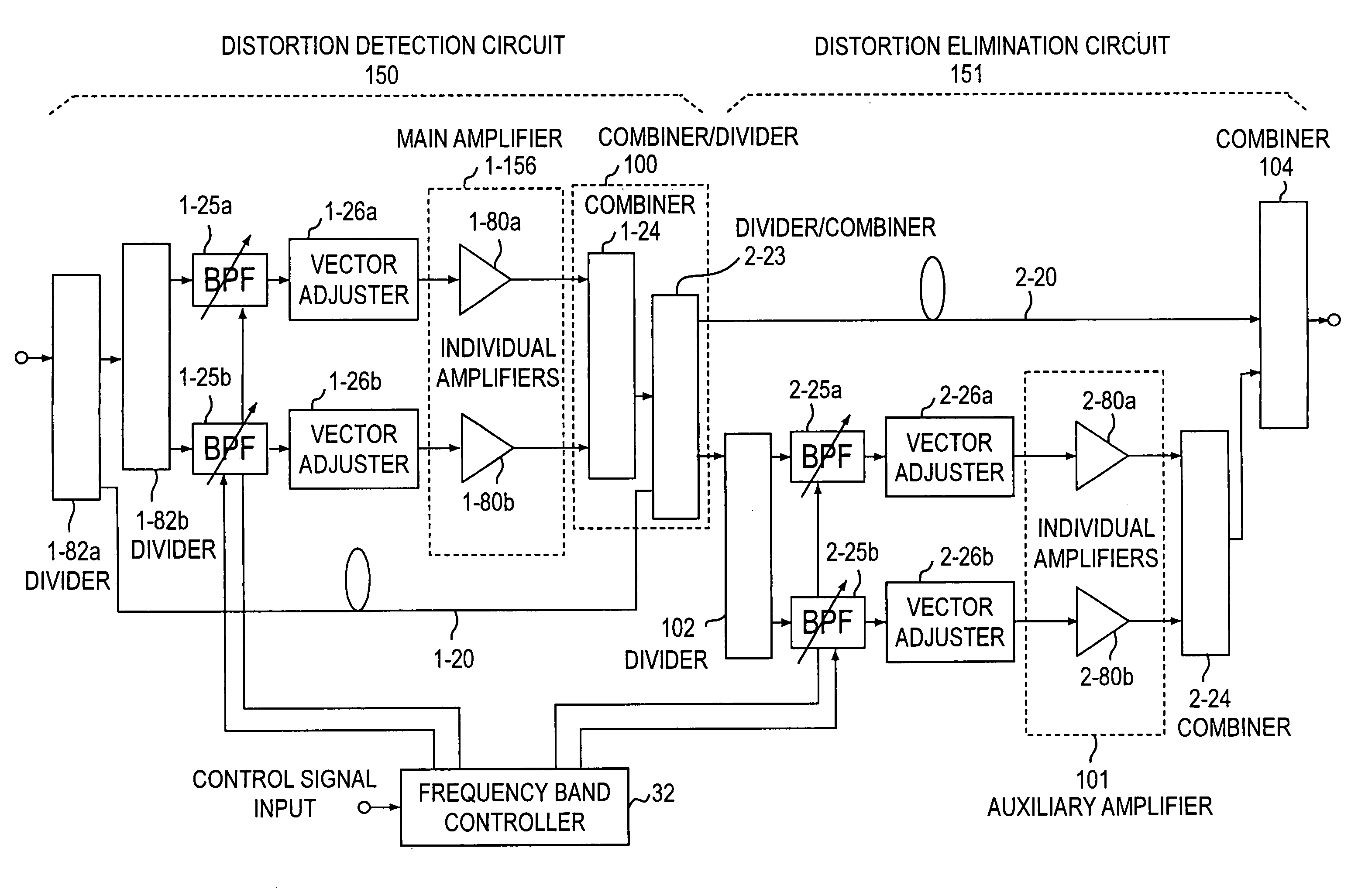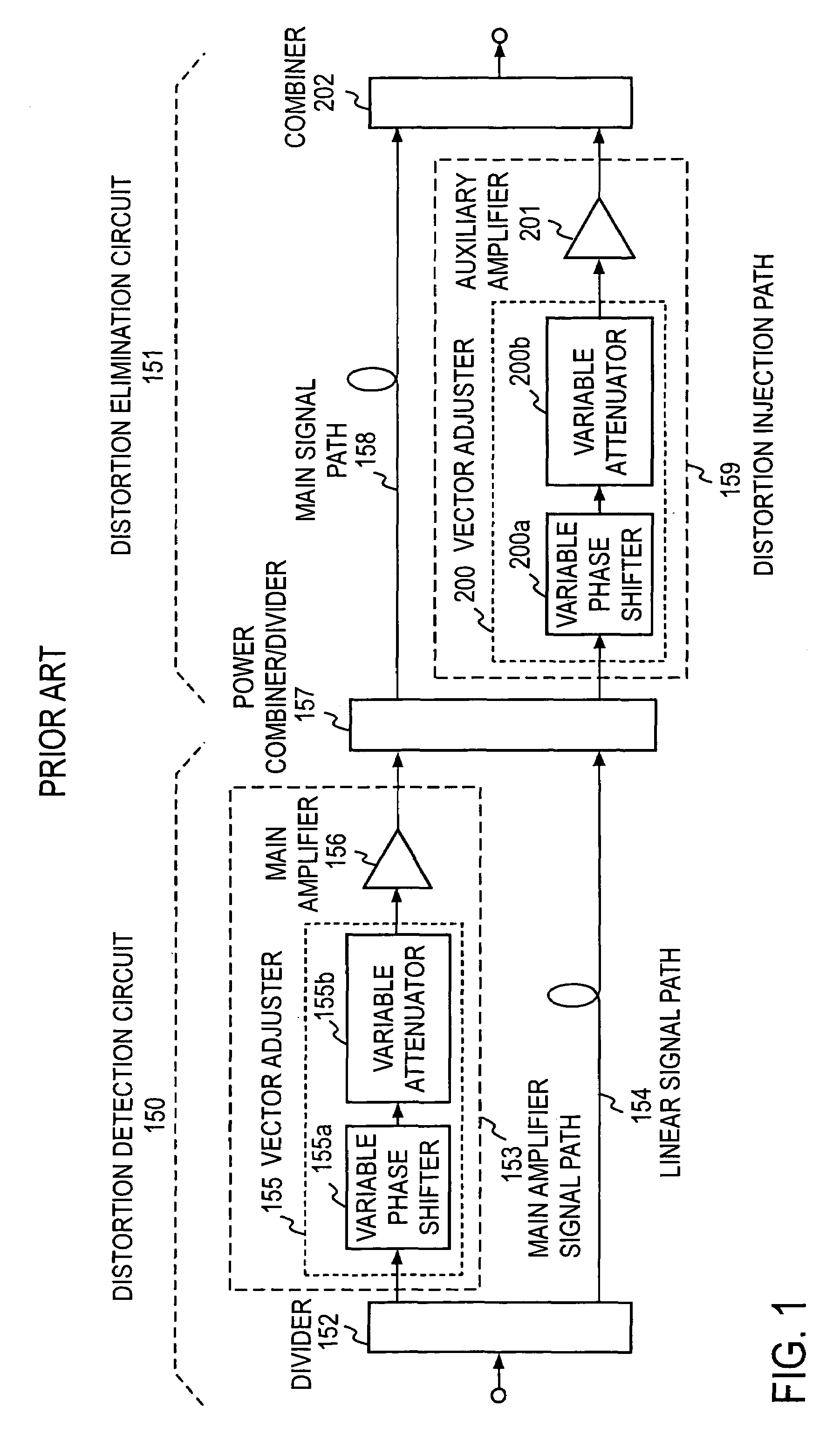Feed forward amplifier for multiple frequency bands
a technology of feed forward amplifier and frequency band, which is applied in the direction of amplifiers, electrical devices, and amplifier modifications to reduce noise influence, can solve the problems of single hardware actually handling a plurality of radio systems that has not yet been implemented, and it is difficult to maintain an excellent balance, so as to achieve adaptive distortion, reduce power consumption, and simplify the configuration of feed forward amplifier collectively amplifying a plurality of frequency bands
- Summary
- Abstract
- Description
- Claims
- Application Information
AI Technical Summary
Benefits of technology
Problems solved by technology
Method used
Image
Examples
first embodiment
1. FIRST EMBODIMENT
[0065]In FIG. 11, Embodiment 1 of a feed forward amplifier according to the present invention is shown. In order to simplify the drawings and explanations for all the embodiments below, the explanation will be given taking the number of used frequency bands to be 2, but in general, two or more frequency bands may be used.
[0066]In the explanation below, “1-” is attached in front of reference numerals of the multiple frequency band signal processing circuit forming the distortion detection circuit and “2-” is attached in front of reference numerals of the multiple frequency band signal processing circuit forming the distortion elimination circuit. However, in the case of intrinsic numerals, the notation is not used.
[0067]A combiner 1-24 of the multiple frequency band signal processing circuit constituting distortion detection circuit 150 functions as a combiner / divider 100, together with a divider 2-23 of the multiple frequency band signal processing circuit constit...
second embodiment
2. SECOND EMBODIMENT
[0075]In FIG. 12, Embodiment 2 is shown. Embodiment 2 is an embodiment in which the multiple frequency band signal processing circuit shown in FIG. 10 has been applied as distortion elimination circuit 151. In the Embodiment 2 feed forward amplifier as well, vector adjustment is performed using vector adjusters 1-26a, 1-26b, 2-26a, and 2-26b for each frequency band. If sufficient isolation is provided between the vector adjustment paths, there is no influence exerted on the vector adjusters of the other frequency bands, even if the vector adjuster of one frequency band is adjusted. Consequently, it is possible to carry out distortion compensation independently for each frequency band. Also, if vector adjustment paths are added, it is possible to flexibly add frequency bands which are distortion compensated.
[0076]An auxiliary amplifier 2-156 of the distortion elimination circuit has one common amplifier 2-91 which simultaneously amplifies a plurality of frequency ...
third embodiment
3. THIRD EMBODIMENT
[0077]In FIG. 13, Embodiment 3 is shown. Embodiment 3 is an example using the multiple frequency band signal processing circuit shown in FIG. 10 as distortion detection circuit 150. The feed forward amplifier of Embodiment 3 also carries out vector adjustment by using, for each frequency band, vector adjusters 1-26a, 1-26b, 2-26a, and 2-26b. If sufficient isolation is provided between the vector adjustment paths, there is no influence exerted on the other vector adjusters, even if the vector adjuster of one frequency band is adjusted. Consequently, it is possible to perform distortion compensation independently for each frequency band. Also, if vector adjustment paths are added, it is possible to flexibly add frequency bands which are distortion compensated.
[0078]Main amplifier 1-156 of distortion detection circuit has one common amplifier 1-91 which simultaneously amplifies a plurality of frequency bands, as shown in FIG. 10. Consequently, there can be expected a...
PUM
 Login to View More
Login to View More Abstract
Description
Claims
Application Information
 Login to View More
Login to View More - R&D
- Intellectual Property
- Life Sciences
- Materials
- Tech Scout
- Unparalleled Data Quality
- Higher Quality Content
- 60% Fewer Hallucinations
Browse by: Latest US Patents, China's latest patents, Technical Efficacy Thesaurus, Application Domain, Technology Topic, Popular Technical Reports.
© 2025 PatSnap. All rights reserved.Legal|Privacy policy|Modern Slavery Act Transparency Statement|Sitemap|About US| Contact US: help@patsnap.com



